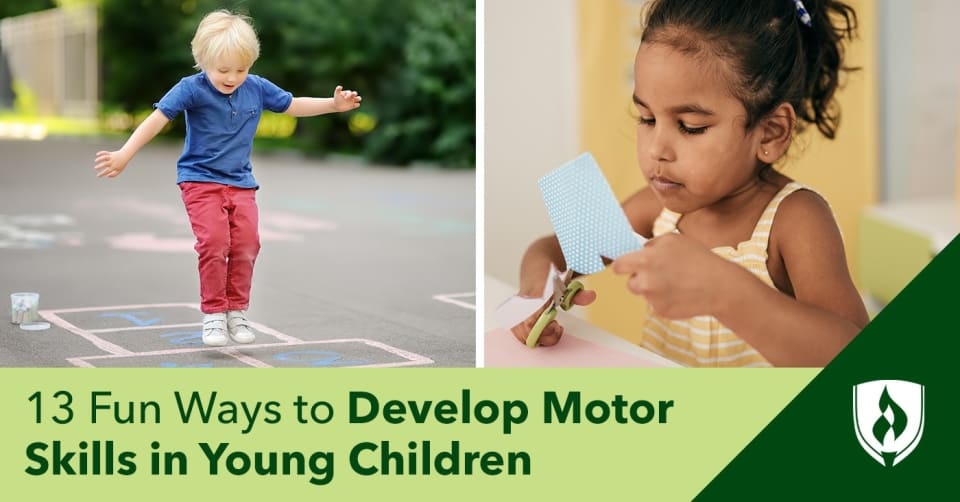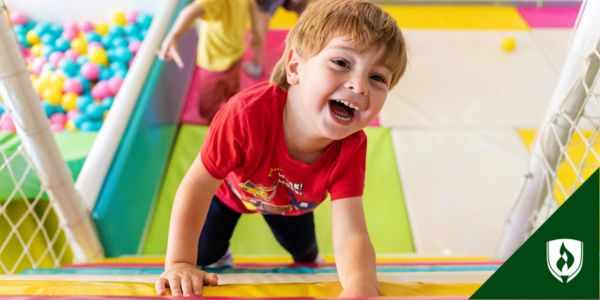
One of the biggest milestones of a child’s life is the day they first learn how to walk. These first steps are a signal to themselves and the world around them that they are ready for something more. They are ready to have new adventures, go to previously unexplored places and quite likely scare their guardians senseless in the process of figuring it all out.
This stage of development is such a special one because it is all about discovering the capabilities of one’s body. The skills that young kids are developing at this stage in life are called motor skills, and they refer to all the movements of big and small muscles that are going to continue to develop into their adult lives.
With this new stage of life comes opportunities for new games and activities, so we wanted to help by putting a list together to help kids and their guardians try some new things and develop these skills in new ways. But before we get to the activities, let’s dig into the types of motor skills and how they’re used.
What are motor skills?
Motor is a word derived from Latin that literally means “mover.” In our modern vernacular, the word motor is most often associated with a car, as it is the part of a car that supplies moving power. This can be a helpful starting point when thinking about what motor skills are in humans. Motor skills are the skills in the human body that are needed to move. To be able to move, the body must engage in a complex process using the brain and muscular and nervous systems.
Fine motor skills vs. gross motor skills
Because movement can be such a complex process in the body, it’s easiest to understand motor skills in two main categories: Gross motor skills and fine motor skills.
Gross motor skills refer to movement skills that require your whole body or larger muscle groups—core muscles, arms and legs. These skills help your body do things like sitting, standing, walking, running and jumping.
Fine motor skills involve smaller muscle groups and are more related to dexterity—muscles in the wrists, hands, fingers, feet and toes. These skills help a body hold objects in the hands, press buttons, brush teeth and wiggle toes.
Many activities will involve the use of both kinds of skills. Since these skills are so key to childhood development, early childhood education (ECE) experts, parents and care providers put a lot of effort into different activities that can help develop both kinds. We’ve compiled a list of thirteen different activities for children that help develop these skills while offering some novel fun along the way.
13 activities to develop motor skills in young children
Here are thirteen fun activities that can be done with young children to help develop both gross and fine motor skills.
1. Gardening
To start the list, consider this age-old activity that involves both gross and fine motor skills for every age and ability of young children. Kids Gardening® offers several ideas on supplies and ways to encourage this useful play.
Whether it is digging, watering, planting or carefully observing, these various garden activities will help any young child develop both small and big muscles as they immerse themselves in nature. As a bonus, gardening offers many other benefits to children beyond motor skills as well.
2. Pompom drop
Did you go get some coffee this morning? Well, there may be a perfect use for that cup before it finds its way to the recycling bin. This idea from Messy Little Monster is a simple activity for young toddlers that involves bright colors and the challenge of gently placing a pom pom in the hole at the top of a cup. Whether this is mixed in with counting or repeatedly dumping the pom poms back out, it is an activity that is sure to help with finger dexterity.
3. The floor is lava!
The floor is lava is a classic game using gross motor skills that involves imagination, bravery and cunning. While many of us now realize that lava isn’t going to be as big of an issue in our adult lives as we may have thought as a child, this game can help stimulate a “real-life adventure” as your little ones work to avoid getting scorched. Hands On As We Grow® highlights some different ways you can play the game by pushing everyone to step, jump or crawl to different surfaces across the room and steer clear of the dreaded lava pits.
4. Cheerios® bird feeder
Anytime an activity involves food and animals, kids will have a hard time passing it up. This is an activity that can help a child develop their fine motor skills by weaving together Cheerios (or other circular cereals) on a pipe cleaner. The best part of this project is that making it is only the beginning—it’s just as much fun to observe the potential birds the project will attract when you hang it up outdoors.
5. Dancing treasure hunt
Dancing and treasure? It’s hard to go wrong with those two things! Dance Teaching Ideas highlights how gross motor skill activities can be set up beforehand with intentionality, or they can be done on a whim by going outside and seeing what you find in nature. Whether you are a planner or a spur-of-the-moment creative thinker, this activity can be a hit.
6. Painting with Q-tips®
This fine motor skills activity, as demonstrated by The Imagination Tree, involves introducing a child to pointillism, or using tiny dots to begin building something bigger. With just a Q-tip and some paint, you can introduce a child to a whole new world of creating art, all while helping them develop dexterity and gentleness in their fingers. We recommend you opt for the washable, toddler-safe types of paint to make your life a little easier.
7. Crab walking challenge
Spending time with a young child can often mean lots of imagination time as different animals. ChoosePT introduces a crab walking challenge—an easy way to bring that imaginative play into further developing gross motor skills. Whether the child is crab walking to the bathroom or doing the more advanced crab walk dance, learning to walk like a crab is sure to develop all of their different major muscle groups.
8. Handwriting techniques
One of the most important fine motor skills that young kids develop is their handwriting. These multisensory techniques are perfect for a school-age child who may be working on developing their writing skills. This entry offers six different ways handwriting activities can be made fun by adding in play tools, freezer bag experiments and other unique ideas to bring this time to life.
9. Ninja game
“Ninja” is a gross motor skills game becoming quite common on playgrounds, as it involves practically no setup, just willing participants. Frugal Fun for Boys and Girls lays out exactly how the game is played. From striking a ninja pose to karate chops and dodges, this is a fun game that can make anyone feel that special sense of power and poise that comes with being a ninja.
10. Ninja craft
After a session of playing ninja and working on those gross motor skills, it could be a good time to transition to a ninja craft involving the fine motor skills. Kids Art & Craft offers tons of ninja craft ideas that could be perfect for making the transition from playtime to quiet time, all the while building some excitement for the next round of the game.
11. Hopscotch
It’s always important to make room for a classic. Hopscotch is a game that has been passed on for generations now because it is a simple activity that helps develop gross motor skills. Play outside with chalk, or, on a rainy day, use tape.
12. Wash the socks
Yes, you read that right. “Washing the socks” is a fine motor skill activity that involves a little bit of setup and a lot of imagination for a child. Days with Grey breaks down this activity that allows a young child to create a “washing machine” and practice placing socks in and out of it, perhaps even going as far as to learn that often mystifying adult activity of finding socks that match.
13. Button stacking
If you have buttons lying around, corral some of them for this fine motor skill activity highlighted by Coffee Cups and Crayons. Children engage their brains and fingers by flattening playdough and attempting to stack a variety of buttons on a spaghetti noodle. They will love the challenge of seeing how many tall towers they can make.
Children are always learning and growing
Hopefully, this list has given you a lot of ideas of different activities you can do with children to continue to develop their vast array of motor skills. If your interest has been piqued in regard to child development and encouraging healthy growth, check out our article “Early Childhood Development Milestones: What You Should Know.”
Related Articles:
- Why Is Art Important for Preschool? 7 Benefits to Know
- What Is Rough and Tumble Play? An Educator’s Guide
Kids Gardening is a registered trademark of National Gardening Association, Inc.
Hands On As We Grow is a registered trademark of Oak Avenue Media LLC.
Cheerios is a registered trademark of General Mills IP Holdings II, LLC.
Q-tips is a registered trademark of Conopco, Inc.




